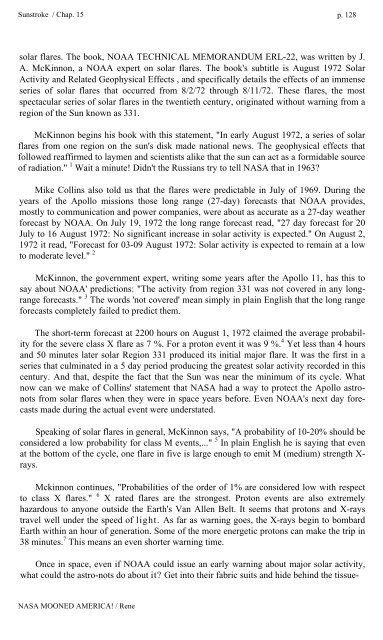Rene-NASA-Mooned-America
Rene-NASA-Mooned-America
Rene-NASA-Mooned-America
Create successful ePaper yourself
Turn your PDF publications into a flip-book with our unique Google optimized e-Paper software.
Sunstroke / Chap. 15 p. 128<br />
solar flares. The book, NOAA TECHNICAL MEMORANDUM ERL-22, was written by J.<br />
A. McKinnon, a NOAA expert on solar flares. The book's subtitle is August 1972 Solar<br />
Activity and Related Geophysical Effects , and specifically details the effects of an immense<br />
series of solar flares that occurred from 8/2/72 through 8/11/72. These flares, the most<br />
spectacular series of solar flares in the twentieth century, originated without warning from a<br />
region of the Sun known as 331.<br />
McKinnon begins his book with this statement, "In early August 1972, a series of solar<br />
flares from one region on the sun's disk made national news. The geophysical effects that<br />
followed reaffirmed to laymen and scientists alike that the sun can act as a formidable source<br />
of radiation." 1 Wait a minute! Didn't the Russians try to tell <strong>NASA</strong> that in 1963<br />
Mike Collins also told us that the flares were predictable in July of 1969. During the<br />
years of the Apollo missions those long range (27-day) forecasts that NOAA provides,<br />
mostly to communication and power companies, were about as accurate as a 27-day weather<br />
forecast by NOAA. On July 19, 1972 the long range forecast read, "27 day forecast for 20<br />
July to 16 August 1972: No significant increase in solar activity is expected." On August 2,<br />
1972 it read, "Forecast for 03-09 August 1972: Solar activity is expected to remain at a low<br />
to moderate level." 2<br />
McKinnon, the government expert, writing some years after the Apollo 11, has this to<br />
say about NOAA' predictions: "The activity from region 331 was not covered in any longrange<br />
forecasts." 3 The words 'not covered' mean simply in plain English that the long range<br />
forecasts completely failed to predict them.<br />
The short-term forecast at 2200 hours on August 1, 1972 claimed the average probability<br />
for the severe class X flare as 7 %. For a proton event it was 9 %. 4 Yet less than 4 hours<br />
and 50 minutes later solar Region 331 produced its initial major flare. It was the first in a<br />
series that culminated in a 5 day period producing the greatest solar activity recorded in this<br />
century. And that, despite the fact that the Sun was near the minimum of its cycle. What<br />
now can we make of Collins' statement that <strong>NASA</strong> had a way to protect the Apollo astronots<br />
from solar flares when they were in space years before. Even NOAA's next day forecasts<br />
made during the actual event were understated.<br />
Speaking of solar flares in general, McKinnon says, "A probability of 10-20% should be<br />
considered a low probability for class M events,..." 5 In plain English he is saying that even<br />
at the bottom of the cycle, one flare in five is large enough to emit M (medium) strength X-<br />
rays.<br />
Mckinnon continues, "Probabilities of the order of 1% are considered low with respect<br />
to class X flares." 6 X rated flares are the strongest. Proton events are also extremely<br />
hazardous to anyone outside the Earth's Van Allen Belt. It seems that protons and X-rays<br />
travel well under the speed of light. As far as warning goes, the X-rays begin to bombard<br />
Earth within an hour of generation. Some of the more energetic protons can make the trip in<br />
38 minutes. 7 This means an even shorter warning time.<br />
Once in space, even if NOAA could issue an early warning about major solar activity,<br />
what could the astro-nots do about it Get into their fabric suits and hide behind the tissue-<br />
<strong>NASA</strong> MOONED AMERICA! / <strong>Rene</strong>


